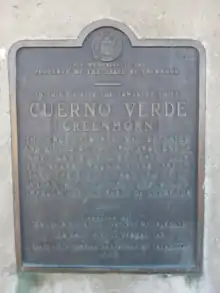Cuerno Verde
Cuerno Verde (unknown – September 3, 1779) was a leader of the Comanche, likely of the Kotsoteka Comanche, in the late 18th century.

Life
Cuerno Verde, which translates to "Green Horn" in English, is the Spanish name originally given to Tavibo Naritgant ("Dangerous Man") because of the green tinted horns that he wore on his head-dress in battle. The English translation of the original Comanche name is "Dangerous Man" .[1] His son inherited both the name and the distinctive head dress from the father, who was killed in combat against the Spanish at Ojo Caliente, in what is now New Mexico, in October 1768. [2]
The success of a series of raids led by the younger Tabivo Naritgant into Nuevo Mexico during the mid to late 1770s called him to the attention of the Spanish Viceroy in Mexico. The Viceroy offered Juan Bautista de Anza the governorship of Nuevo Mexico in exchange for him dealing with Tavibo Naritgant. De Anza moved to Nuevo Mexico and assumed the Governorship and for a year, studied past expeditions against and encounters with Cuerno Verde. A year later, in August 1779, de Anza led a mixed force of 500 to 800 Spanish troops and Ute, Apache, and Pueblo auxiliaries on a punitive expedition against the Comanche. [3][4]
The Comanche and Spanish forces met in a series of running battles between August 31 and September 3, 1779; Tabivo Naritgant was killed in combat, along with his first-born son and fifteen others, on September 3 somewhere between the present day cities of Pueblo, Colorado and Colorado City, Colorado, probably in a gully of the St. Charles River. Hostilities in the area decreased following his death.[5]
The "green horn" head-dress of Cuerno Verde was taken from the battlefield and presented to the Viceroy by de Anza. The Viceroy in turn presented the headdress to the King of Spain. The King, in turn presented the headdress to the Pope. The headdress remains on display at the Vatican museum in Rome.[6]
Although Anza called him a "cruel scourge" and made note in his diaries of atrocities attributed to him, many modern Comanches question the veracity of Anza's statements and maintain that Tabivo Naritgant was only meeting the obligations of a responsible Comanche leader of the period.[7]
Legacy
Tabivo Naritgant gave the English translation of his Spanish name to Greenhorn Mountain and the Greenhorn Valley in south-central Colorado.[1]
Gallery
 Cuerno Verde marker on Colorado Highway 67
Cuerno Verde marker on Colorado Highway 67 Cuerno Verde Mountain
Cuerno Verde Mountain
Notes
- "Juan Bautista de Anza & Cuerno Verde".
- Martinez (2004). Anza and Cuerno Verde. p. 16.
- Martinez (2004). Anza and Cuerno Verde. pp. ppg. 23, 52.
- "Juan Bautista de Anza and the Battle of Greenhorn". Archived from the original on 2007-02-08.
- Dodds (1994). They All Came To Pueblo. p. 13.
- Martinez (2004). Anza and Cuerno Verde. p. 98.
- Perez (2001-09-02). "Anza panelists present Comanches' viewpoint". The Pueblo Chieftain.
References
- Martinez, Wilfred O. (2004). Anza and Cuerno Verde: Decisive Battle. Pueblo, Colorado: El Escritorio. ISBN 0-9628974-9-3.
- Dodds, Joanne West (1994). They All Came To Pueblo: A Social History. Virginia Beach, Virginia: Donning Company. ISBN 0-89865-908-6.
- Miller, Ione. "Juan Bautista de Anza and the Battle of Greenhorn". Archived from the original on February 8, 2007. Retrieved 2007-01-27.
- "Juan Bautista de Anza & Cuerno Verde". Retrieved 2007-01-27.
- Perez, Gayle (2001-09-02). "Anza panelists present Comanches' viewpoint". The Pueblo Chieftain.
| Wikimedia Commons has media related to Cuerno Verde. |